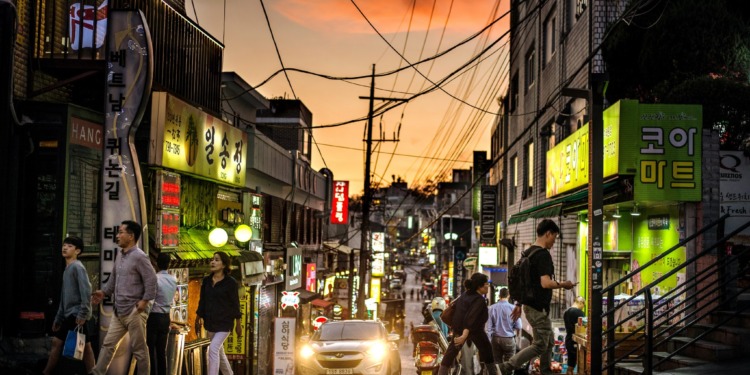South Korea experienced unexpected tragedy in the form of a lethal crowd crush over Halloween weekend in Itaewon, a popular district in Seoul for teenagers and young people to go out.
After a similar incident occurred almost exactly a year ago at Astroworld Festival in Houston (read more about that below), the questions arise: Can similar incidents caused by overcrowding be predicted and avoided? Who should be responsible for managing this threat to public safety?
Halloween, a popular tradition in Itaewon, turns tragic in post-COVID debut
Halloween is a relatively recent addition to the South Korean social calendar, which has grown in popularity over the past few years. This is due in part to the growing number of students who study abroad and return to South Korea bringing Western, in this case American, traditions with them.
Seoul’s celebration of the holiday centres around Itaewon, a neighbourhood that is associated with the its expatriate community. Itaewon is home to the Yongsan Garrison, the headquarters for U.S. military forces stationed in South Korea, and is also a popular destination for tourists, with the Hamilton Hotel at its centre.
Due to this international influence, the neighbourhood is associated with more liberal values than traditionally conservative South Korea. Young people especially flock here in search of a good time and somewhere to let their hair down.
Halloween usually draws large crowds to this neighbourhood, but it has been three years since the last time Seoul had a Halloween without COVID restrictions.
South Korea was one of the last countries to loosen its pandemic restrictions, and this event marked the first time that costume masks were allowed to replace surgical masks.
For this reason, the gruesome scenes coming out of the incident are all the more incongruous. People in bright costumes, exaggerated makeup, and fancy dress turned into one indiscriminate sea of people.
Tragedy Occurs
As of writing, the death toll from the incident, which took place at about 10:20 (KST), has reached 153 with more than 80 others injured.
The exact details are still unfolding, but it is clear that there was a crowd collapse at the bottom of a sloped, narrow alley near Itaewon station’s second exit and the Hamilton Hotel.
Crowd crushes and collapses are catastrophic incidents that happen when a body of people becomes dangerously overcrowded. When a crowd reaches or exceeds the density of 4 to 5 people per square metre, individuals are crushed and asphyxiated. At this density, a crowd can start to act like fluid, carrying individuals with its motion.
The neighbourhood of Itaewon stretches along one central street that runs from east to west and has many small alleys leading off of it, where people frequent the busy bars and chic eateries for which the district is known.
As people emerged from the train station in increasing numbers and piled into the neighbourhood at about 10pm, the number of people in the small area near the train station was reported to be 10 times higher than normal.
Social media footage showed hundreds of people packed into one of these alleys, as officials and police tried to pull them free. The videos also showed people climbing up onto buildings and other raised structures to free themselves from the pressure of the surging crowd.
It seems as if a few people fell at the top of the alleyway and caused the force of the crowd to cascade downward like dominoes, adding weight and pressure onto the crowd that was penned into the narrow interior of the alleyway.
Choi, the Yongsan district fire chief, said all the deaths were likely from the crush in the single narrow alley.
97 of the victims were women and 56 were men. It is likely that this disparity is a result of the proportion of genders in the crowd. There is no evidence that women are more prone than men to compressive asphyxiation, the most common cause of death in crowd crush incidents.
The vast majority of the victims were in their teens and twenties, young people for whom the area was a well-known place for a night of festivities.
It is unclear whether there was a triggering event for the stampede. Some reports suggested that people were rushing towards Hamilton Hotel due to rumours of an unidentified celebrity spotting.
The volume of people made it difficult for first responders to arrive quickly. Video footage on social media show what eyewitness accounts corroborate – rows of civilians performing CPR on unresponsive party-goers whilst waiting for paramedics.
Related Articles: There Are No ‘Natural Disasters’ | South Korean Economy Braces for Loss as Boy Band BTS Pauses Music for Military
Travis Scott’s infamous Astroworld comes back to haunt us
The eyewitness reports have an eerie familiarity to them. Almost exactly a year ago, on November 5, 2021, there was a fatal crowd crush at the 2021 Astroworld Festival, a music event founded by American musician Travis Scott in Houston, Texas.
The crowd at the festival numbered 50,000. Survivors of the stampede described the feeling of being carried involuntarily with the tide of people and being unable to lift their arms due to the pressure of the crowd. Many also recalled the shouts of those around them, as people struggled to breath, and the memory of people falling underneath the crowd.
Most of the casualties occurred as the result of crowd collapse, the same phenomenon that killed dozens in Itaewon.
In the spot where a few people fell first, other people lost their footing, which set off a chain reaction. Bodies piled up in this spot as other people were unable to withstand the pressure of the crowd and remain standing. Others were asphyxiated whilst being held upright by the force of the crowd.
Eyewitnesses at both catastrophes described seeing unresponsive people upright in the crowd.
By the end of Scott’s performance at Astroworld, eight people had died, and two more would die in hospital over the following days. The cause of death for all 10 was reported to be accidental compressive asphyxiation. Twenty-five people were hospitalised, and more than 300 people were treated for injuries at the festival’s field hospital.
In the aftermath, controversy raged over Travis Scott’s actions during his performance. Scott stopped the concert at one point to check on a fan near the front of the crowd, but chose to continue the concert even as sections of the crowd chanted for him to stop. He even brought Drake out on stage for a surprise performance, which excited the crowd further and exacerbated the problem.
Travis Scott claimed to have been unaware of the chaos unfolding beneath him over the course of the performance. Within the past few weeks, on October 21, Scott finally settled lawsuits relating to the incident.
Media criticism of the rapper’s reaction, or lack thereof, during the concert disguised the more likely culprit for the disaster: poor planning.
The event organisers, Live Nation, were accused of unsafe barricade layouts and ignoring pleas for help from the attendees. One video that circulated online showed a woman being ignored whilst attempting to inform a backstage crew member that people were dying in the crowd.
In situations like these, prevention is more effective than reaction. Once crowd density reaches a critical “crushing point” (a density of 4 to 5 people per square metre), asphyxiation can happen quickly.
The crowds necessary to cause situations like these are often in the tens or hundreds of thousands, making it difficult to access individuals at the centre of the crowd for minutes or even hours. Additionally, paramedics trying to force their way into crowds to reach those affected can often worsen the situation, delaying the response time for aid.
Additionally, those affected might struggle to make their emergency known. People whose arms are trapped and are short of breath will struggle to draw attention to themselves. At Astroworld, even with whole crowds of people shouting, the emergency still went largely unnoticed as it happened.
Both incidents were characterised by slow emergency response. In each case, by the time the situation was obviously dangerous, it had passed the point where first responders would be able to access victims safely and quickly.
Astroworld was a private event rather than a public holiday, but more people were present than organisers had planned. This is partly due to the number of people who rushed the flimsy barriers in order to enter the festival, in addition to accusations that it was oversold in the first place. Both of these factors contributed to the lethal overcrowding. Victims and onlookers alike were quick to cast blame onto event organisers, pointing to the series of overlooked safety measures that could have prevented the tragedy.
Methods and practices for preventing crowd surges in open environments, like a city neighbourhood rather than a large arena, are more challenging. In Itaewon and its crowded alleyways, there were simply lots of small venues ready to welcome the return of partiers and a sense of normality.
The Aftermath: Domestic and international reactions
For the moment, questions are being directed to the South Korean government, who have opened an investigation into the incident and whether it could have been prevented.
Many people have noted the small police presence in the area last night, even though crowds of up to 100,000 people were expected.
Lee Young-ju, a professor from the Department of Fire and Disaster at the Univeristy of Seoul said:
“District events held by local governments or institutions have to have safety plans and measures if more than 1,000 people are expected to participate. But this was a district event without a specific organizer, lacking the safety control function.”
After 125 died in a stampede at a football game in Indonesia earlier this month, in addition to the Astroworld incident a year ago, it is becoming clear that events of this nature are no longer unique tragedies. As the world continues to emerge from COVID-19 lockdowns and gather in ever larger crowds, shall it fall to individuals, organisers, or governments to manage this threat and its effect on public safety?
As Sunday morning dawned, South Korea’s President Yoon Suk-yeol announced a national period of mourning that will last from today “until the accident is brought under control.”
He said:
“[The government] will thoroughly investigate the cause of the incident and make fundamental improvements to ensure the same accident does not occur again in the future. My heart is heavy and it is difficult to contain my sorrow.”
The task of identifying the victim’s bodies was 90% complete by midday on Sunday, with some delays occurring in the effort to identify teenagers who were without adult identification and foreigners.
As many as 26 foreigners have been reported among those killed in the crowd crush.
Many foreign leaders have reached out to South Korea offering condolences, including US President Biden, the UK’s Prime Minister Rishi Sunak, and Pope Francis.
And let us pray to the Risen Lord also for those – especially the young – who died in #Seoul last night as a tragic consequence of a sudden crowd surge.
— Pope Francis (@Pontifex) October 30, 2022
From the United States, to Indonesia, to South Korea, tragic events of this kind are not uncommon, although they evoke a specific sense of horror. Hopefully, South Korea’s investigation into this horrific crowd crush will shed light for everyone on how incidents like these can be managed and avoided in the future.
As much as people want to find a place to put blame, this was simply a recipe for disaster hiding in plain sight. If anything, the scale of tragedy should cause people to think about this risk in the future, so that these lives will not have been lost in vain.
Editor’s Note: The opinions expressed here by the authors are their own, not those of Impakter.com — In the Featured Photo: Itaewon, the scene of the lethal crowd crush, at sunset. Featured Photo Credit: Jongsu Pyeon.










